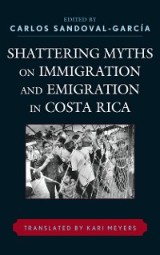Details

Shattering Myths on Immigration and Emigration in Costa Rica
|
134,99 € |
|
| Verlag: | Lexington Books |
| Format: | EPUB |
| Veröffentl.: | 27.12.2010 |
| ISBN/EAN: | 9780739144695 |
| Sprache: | englisch |
| Anzahl Seiten: | 366 |
DRM-geschütztes eBook, Sie benötigen z.B. Adobe Digital Editions und eine Adobe ID zum Lesen.
Beschreibungen
Shattering Myths on Immigration and Emigration in Costa Rica provides the first comprehensive examination of transnational migration patterns into and out of Costa Rica. This impressive edited volume brings together the work of 18 top scholars from diverse social science backgrounds to analyze Costa Rican migration patterns in the era of globalization. The first section focuses on immigration in Costa Rican history, including chapters on Nicaraguan, North American and European immigration to the country as well a chapter on transnational migration within Central America. The second part centers on the social and political status of Nicaraguans in Costa Rica that make up a sizable portion of the working-class similar to Mexican immigrants in the southwestern United States. The third section of the book analyzes outmigration of Costa Ricans with chapters on the role of international remittances sent back to Costa Rica (a major source of income in contemporary Latin America) and particular migration patterns of Costa Ricans living in the northeastern United States. The fourth part of the collection examines the timely topic of gender and cross-border migration with emphases on women in the actual migration transit process and the vulnerability of immigrant women in different industries including agriculture and sex tourism. The concluding chapters emphasize the social and symbolic images of immigrants to Costa Rica including the construction of in-group and out-group identities, the use of symbolic violence and racism against immigrants. This volume was originally published in Costa Rica in 2007 and reprinted in 2008 by the University of Costa Rica Press.
Shattering Myths on Immigration and Emigration in Costa Rica is a major contribution to scholarship on Central American immigration by the sheer number of topics it covers by an internationally recognized team of scholars from several disciplines.
Chapter 1 Introduction
<br>Part 2 Part I: Migrant Communities in Costa Rica
<br>Chapter 3 Chapter 1. Foreign immigration in Costa Rican history
<br>Chapter 4 Chapter 2. The quantitative dimension of Nicaraguan immigration in Costa Rica: From myth to reality
<br>Chapter 5 Chapter 3. Selected socio-demographic aspects of the U.S., Canadian, and European residents in Costa Rica
<br>Chapter 6 Chapter 4. Replacement migration: New poles of exclusion in transborder migrations in Central America
<br>Part 7 Part II: Immigration and Public Policies
<br>Chapter 8 Chapter 5. Nicaraguan migration to Costa Rica and public policies
<br>Chapter 9 Chapter 6. The Social Security Health System and its uses by Nicaraguans in Costa Rica
<br>Part 10 Part III: Costa Rican Emigration
<br>Chapter 11 Chapter 7. Family remittances sent by Costa Ricans in the United States
<br>Chapter 12 Chapter 8. The first Costa Rican emigrants to New York and New Jersey
<br>Chapter 13 Chapter 9. Toward a transnational conception in the study of and attention to Costa Rican migration
<br>Part 14 Part IV: Immigration and Gender
<br>Chapter 15 Chapter 10. Vulnerability to violence in immigration: Nicaraguan and Panamanian women in migratory transit to Costa Rica
<br>Chapter 16 Chapter 11. Transnational reproduction: Reproductive health, limitations and contradictions for working Nicaraguan migrant women in Costa Rica
<br>Chapter 17 Chapter 12. Working migrant women and nontraditional agricultural exports: Women workers in packing plants in Costa Rica
<br>Chapter 18 Chapter 13. "They're machistas, they treat them badly": Comparative transnational masculinity in sex tourism
<br>Part 19 Part V: Social Imaginaries of Migration
<br>Chapter 20 Chapter 14. The alterity joke: The nightmare of being the other
<br>Chapter 21 Chapter 15. Jokes about Nicaraguans in Costa Rica: Symbolic barriers, social control mechanisms, identity constructors
<br>Chapter 22 Chapter 16. NICA/ragüense: The making of the documentary
<br>Chapter 23 Chapter 17. Challenges in migration research: Reflections from Costa Rica
<br>Part 2 Part I: Migrant Communities in Costa Rica
<br>Chapter 3 Chapter 1. Foreign immigration in Costa Rican history
<br>Chapter 4 Chapter 2. The quantitative dimension of Nicaraguan immigration in Costa Rica: From myth to reality
<br>Chapter 5 Chapter 3. Selected socio-demographic aspects of the U.S., Canadian, and European residents in Costa Rica
<br>Chapter 6 Chapter 4. Replacement migration: New poles of exclusion in transborder migrations in Central America
<br>Part 7 Part II: Immigration and Public Policies
<br>Chapter 8 Chapter 5. Nicaraguan migration to Costa Rica and public policies
<br>Chapter 9 Chapter 6. The Social Security Health System and its uses by Nicaraguans in Costa Rica
<br>Part 10 Part III: Costa Rican Emigration
<br>Chapter 11 Chapter 7. Family remittances sent by Costa Ricans in the United States
<br>Chapter 12 Chapter 8. The first Costa Rican emigrants to New York and New Jersey
<br>Chapter 13 Chapter 9. Toward a transnational conception in the study of and attention to Costa Rican migration
<br>Part 14 Part IV: Immigration and Gender
<br>Chapter 15 Chapter 10. Vulnerability to violence in immigration: Nicaraguan and Panamanian women in migratory transit to Costa Rica
<br>Chapter 16 Chapter 11. Transnational reproduction: Reproductive health, limitations and contradictions for working Nicaraguan migrant women in Costa Rica
<br>Chapter 17 Chapter 12. Working migrant women and nontraditional agricultural exports: Women workers in packing plants in Costa Rica
<br>Chapter 18 Chapter 13. "They're machistas, they treat them badly": Comparative transnational masculinity in sex tourism
<br>Part 19 Part V: Social Imaginaries of Migration
<br>Chapter 20 Chapter 14. The alterity joke: The nightmare of being the other
<br>Chapter 21 Chapter 15. Jokes about Nicaraguans in Costa Rica: Symbolic barriers, social control mechanisms, identity constructors
<br>Chapter 22 Chapter 16. NICA/ragüense: The making of the documentary
<br>Chapter 23 Chapter 17. Challenges in migration research: Reflections from Costa Rica
Carlos Sandoval-Garc'a is a professor at the Communication Studies School and Institute for Social Research at the University of Costa Rica.


















